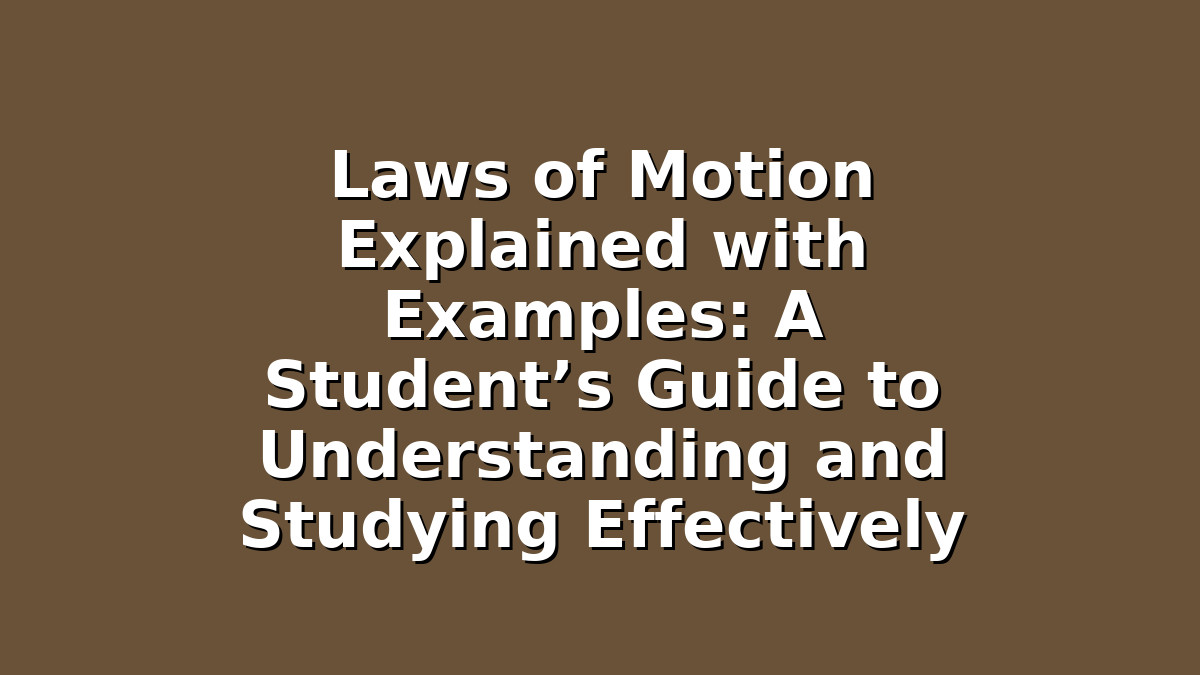When you’re preparing for exams, especially in subjects like physics, understanding core concepts deeply makes all the difference. One topic that often appears on tests and is fundamental to physics is Newton’s Laws of Motion. These laws describe how objects move and interact, and mastering them can boost your confidence and improve your exam scores.
In this article, we will break down the three Laws of Motion with clear explanations and examples. Plus, you’ll get practical study tips to help you learn and remember these principles effectively. Whether you’re struggling with physics or aiming to ace your next exam, this guide is designed just for you.
1. Newton’s First Law of Motion: The Law of Inertia
What is it?
Newton’s First Law states that an object at rest will stay at rest, and an object in motion will continue moving at a constant velocity unless acted upon by an external force. This is often called the Law of Inertia.
Example:
Imagine a soccer ball sitting on the grass. It won’t move unless you kick it. Once kicked, it will roll until friction or another force (like a player stopping it) slows it down and stops it.
Study Tips:
– Visualize everyday examples: Try to find situations around you that demonstrate inertia, like a book on a table or a bike coasting after you stop pedaling. This makes the law easier to remember.
– Draw diagrams: Sketching objects and forces acting on them can help you see why things move or stay still.
– Make flashcards: Write the law on one side and an example on the other. Reviewing these regularly can reinforce your understanding.
– Relate to exam questions: Many exams ask you to explain why an object behaves a certain way. Practice by explaining the first law in your own words and linking it to real-life scenarios.
2. Newton’s Second Law of Motion: The Law of Acceleration
What is it?
Newton’s Second Law explains how the motion of an object changes when a force is applied. It’s often summed up by the formula:
Force (F) = Mass (m) × Acceleration (a)
This tells us that the force acting on an object causes it to accelerate, and the acceleration depends on the object’s mass.
Example:
If you push an empty shopping cart and a full one with the same force, the empty cart will accelerate faster because it has less mass.
Study Tips:
– Understand the formula deeply: Don’t just memorize F = m × a, but understand what each term means and their units (Newton for force, kilograms for mass, meters per second squared for acceleration).
– Solve numerical problems: Practice calculating force, mass, or acceleration from given values. This builds confidence and familiarity.
– Use real-life analogies: Think about why heavier objects are harder to push or stop. This helps anchor abstract ideas in reality.
– Create concept maps: Connect the second law with concepts like velocity, force, and acceleration to see the bigger picture.
– Practice explaining: Try teaching the concept to a friend or family member. Teaching is a great way to reinforce your own understanding.
3. Newton’s Third Law of Motion: Action and Reaction
What is it?
Newton’s Third Law states that for every action, there is an equal and opposite reaction. This means forces always come in pairs.
Example:
When you jump off a boat onto a dock, you push the boat backward (action), and the boat pushes you forward onto the dock (reaction).
Study Tips:
– Look for force pairs: Identify action-reaction pairs in problems or everyday life, like walking (your foot pushes back on the ground, the ground pushes you forward).
– Use physical demonstrations: Try simple experiments like blowing up a balloon and letting it go to see the reaction force pushing it forward.
– Connect to other laws: Understand how the third law relates to the first and second laws to build a cohesive understanding.
– Write your own examples: Creating examples helps personalize the learning process and deepens your comprehension.
– Practice with diagrams: Drawing force pairs acting on objects clarifies how these forces interact.
Wrapping Up: Tips for Effective Exam Preparation on Laws of Motion
– Start early: Don’t cram. Give yourself enough time to understand each law with examples.
– Use active learning: Instead of passively reading, write notes, draw diagrams, and solve problems.
– Stay consistent: Regular revision, even for 15 minutes daily, can improve retention.
– Group study: Explaining laws to peers and hearing their perspectives can reinforce concepts.
– Use mnemonics: For example, for the three laws you can use “Inertia, Force, Action-Reaction” as a quick recall system.
– Practice past papers: Familiarize yourself with how exam questions are framed, and practice writing clear, concise answers.
Remember, mastering Newton’s Laws of Motion is not just about memorizing; it’s about understanding how forces affect motion in the world around you. With patience, practice, and the right strategies, you’ll find these concepts becoming second nature.
Good luck with your studies! Keep pushing forward—you’ve got this!

Responses